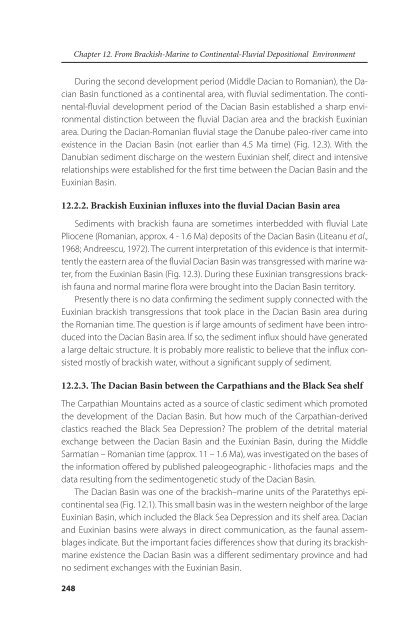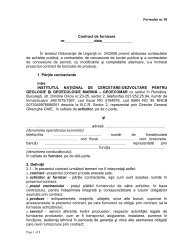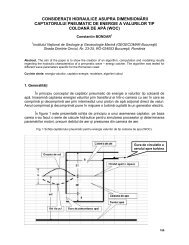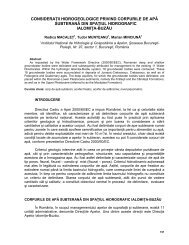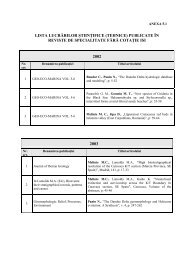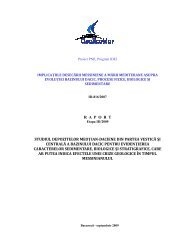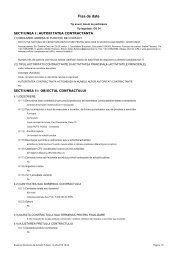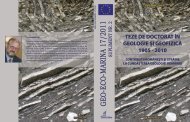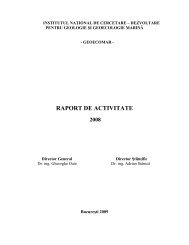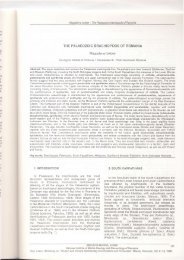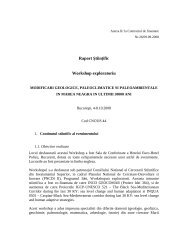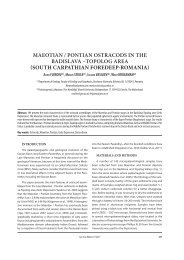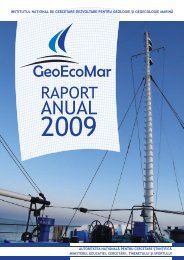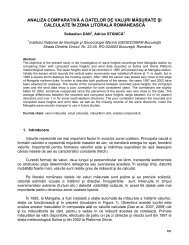DACIAN BASIN - GeoEcoMar
DACIAN BASIN - GeoEcoMar
DACIAN BASIN - GeoEcoMar
Create successful ePaper yourself
Turn your PDF publications into a flip-book with our unique Google optimized e-Paper software.
248<br />
Chapter 12. From Brackish-Marine to Continental-Fluvial Depositional Environment<br />
During the second development period (Middle Dacian to Romanian), the Dacian<br />
Basin functioned as a continental area, with fluvial sedimentation. The continental-fluvial<br />
development period of the Dacian Basin established a sharp environmental<br />
distinction between the fluvial Dacian area and the brackish Euxinian<br />
area. During the Dacian-Romanian fluvial stage the Danube paleo-river came into<br />
existence in the Dacian Basin (not earlier than 4.5 Ma time) (Fig. 12.3). With the<br />
Danubian sediment discharge on the western Euxinian shelf, direct and intensive<br />
relationships were established for the first time between the Dacian Basin and the<br />
Euxinian Basin.<br />
12.2.2. Brackish Euxinian influxes into the fluvial Dacian Basin area<br />
Sediments with brackish fauna are sometimes interbedded with fluvial Late<br />
Pliocene (Romanian, approx. 4 - 1.6 Ma) deposits of the Dacian Basin (Liteanu et al.,<br />
1968; Andreescu, 1972). The current interpretation of this evidence is that intermittently<br />
the eastern area of the fluvial Dacian Basin was transgressed with marine water,<br />
from the Euxinian Basin (Fig. 12.3). During these Euxinian transgressions brackish<br />
fauna and normal marine flora were brought into the Dacian Basin territory.<br />
Presently there is no data confirming the sediment supply connected with the<br />
Euxinian brackish transgressions that took place in the Dacian Basin area during<br />
the Romanian time. The question is if large amounts of sediment have been introduced<br />
into the Dacian Basin area. If so, the sediment influx should have generated<br />
a large deltaic structure. It is probably more realistic to believe that the influx consisted<br />
mostly of brackish water, without a significant supply of sediment.<br />
12.2.3. The Dacian Basin between the Carpathians and the Black Sea shelf<br />
The Carpathian Mountains acted as a source of clastic sediment which promoted<br />
the development of the Dacian Basin. But how much of the Carpathian-derived<br />
clastics reached the Black Sea Depression? The problem of the detrital material<br />
exchange between the Dacian Basin and the Euxinian Basin, during the Middle<br />
Sarmatian – Romanian time (approx. 11 – 1.6 Ma), was investigated on the bases of<br />
the information offered by published paleogeographic - lithofacies maps and the<br />
data resulting from the sedimentogenetic study of the Dacian Basin.<br />
The Dacian Basin was one of the brackish–marine units of the Paratethys epicontinental<br />
sea (Fig. 12.1). This small basin was in the western neighbor of the large<br />
Euxinian Basin, which included the Black Sea Depression and its shelf area. Dacian<br />
and Euxinian basins were always in direct communication, as the faunal assemblages<br />
indicate. But the important facies differences show that during its brackishmarine<br />
existence the Dacian Basin was a different sedimentary province and had<br />
no sediment exchanges with the Euxinian Basin.


